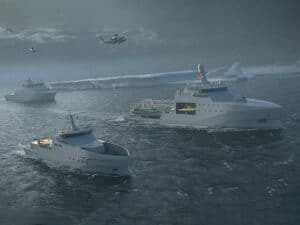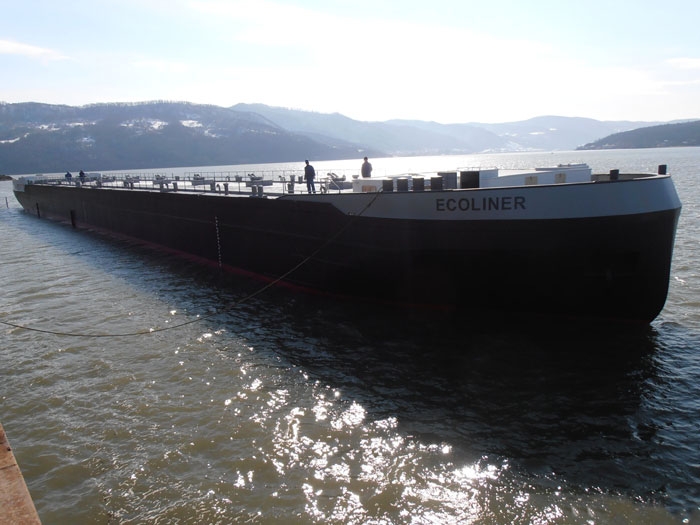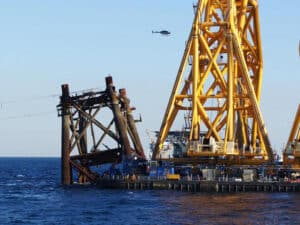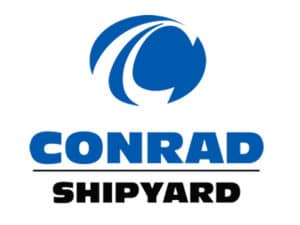
Damen launches LNG fueled inland tanker
Written by Nick Blenkey
Launched at Damen's Romanian shipyard, vessel will be completed in the Netherlands
MARCH 6, 2015 — Damen Shipyards Group’s Galati, Romania, yard recently launched the first LNG-fueled Damen EcoLiner inland shipping tanker, designed to give inland shipping operators much-needed fuel economy while cutting emissions. It has been developed with the help of more than €1.1 million in co-financing from the EU as part of the Trans-European Transport Network Program’s “LNG Masterplan for Rhine-Main-Danube” project
The design combines conventional, proven engineering with sustainable innovations that include the world’s first installations of the ACES (Air Chamber Energy Saving) air-lubricated hull, a gas-electrical shaft propulsion system and a Van der Velden Flex tunnel installation.
The pioneering vessel reduces fuel costs by up to 25%. Its efficiency was confirmed by comprehensive tank testing recently completed by Damen at the MARIN research institute..
According to Simon Provoost, Product Director Inland Waterway Transport at Damen Shipyards, testing how the design combined multiple innovations was very important so that Damen could offer the 3,040 cu.m capacity EcoLiner to the market with utmost confidence.
“After successfully testing at MARIN, we can now complete the build in the Netherlands and we’re talking with a number of interested parties,” he says. “Fuel accounts for a very large proportion of inland shipping costs, so if operators can save 20% or more, that generates a lot of interest,”
“Every part of the EcoLiner has been designed to reduce fuel consumption,” Mr. Provoost continues. “That, combined with low-emission LNG instead of marine diesel, makes the EcoLiner easily the greenest inland shipping vessel in Europe. It’s increasingly important for owners and clients to demonstrate sustainable operations and prepare for future ‘green corridors’ subject to inland emissions regulations.”
The EcoLiner project is managed by Damen Shipyards Hardinxveld. Rob Schuurmans, project manager and the initiator of the concept says: “With the hull built in Romania and installation and outfitting of all main systems in the Netherlands, including all generator-gas engines, power management, propulsion and steering gear, we make efficient use of our specialized facilities. The ship is 110 m long and is Bureau Veritas-classed. Delivery is scheduled in the summer of 2015.”
The first EcoLiner will be delivered as a tanker, however the modular design can be built to transport any commodity, including containers and dry bulk. The complete LNG installation, including tanks with bunker capacity of approximately 45 cu,m LNG, is located aft of the accommodations, ensuring that the configuration forward of the cofferdam can be entirely tailored to customer-specific requirements.
The Central Commission for the Navigation of the Rhine and the United Nations Economic Commission for Europe (ADN-UNECE) has approved the gas-powered design, meaning the vessel can travel on all international inland waterways.
INNOVATIONS
The EcoLiner is the first vessel to feature the ACES air-lubricated hull, originally developed at former Damen shipyard Bodewes. In tank testing and full-scale trials, the ACES concept has demonstrated dramatic fuel savings of up to 15% depending on speed and load.
“People often think of air lubrication as bubbles running underneath the hull,” Mr. Provoost explains. “But ACES is very different. The air is held in chambers under the hull and you push a small amount of air into the chamber to compensate for any air that might escape while underway. It’s a simple concept, but delivers substantial savings.”
Although electric shaft propulsion in combination with the Van der Velden Flex Tunnel, is not new to inland shipping, the EcoLiner is the first to combine LNG-fueling with electrical shaft driven propulsion and steering gear instead of electric driven rudder propellers.
The EcoLiner is the first Damen vessel delivered with the retractable Flex tunnel, which reduces resistance, making it possible to install larger, high efficiency ducted propellers.
“The inland shipping industry has shown the most success with relatively conventional propulsion installations,” Mr. Provoost says. “Our aim was to get the highest efficiency with the least maintenance – that’s why we’ve gone for a modern take on proven engineering. Installing the retractable Van der Velden Flex tunnel further increases fuel efficiency.”
Inland shipping vessels typically use shaft tunnels to ensure optimal water flow to larger, more efficient propellers at shallow drafts. The downside of conventional tunnels is an increase in hull resistance. Moreover, inland ships are loaded and therefore sail in deeper water conditions for about 85 percent of the time. During these conditions, the Van der Velden Flex tunnel is retracted to avoid added resistance. When sailing at shallow drafts, the Van der Velden Flex tunnel deploys to ensure sufficient water flow to the propellers and maintain their efficiency.
“Our solution of two shaft lines with a FLex Tunnel, high efficiency nozzle propellers and steering gear delivers the most cost effective performance with the least maintenance,” says Mr. Provoost.
The EcoLiner’s power management system for its four LNG fueled generator sets ensures optimum engine loads and reduced fuel consumption upstream and downstream, An optional waste heat recovery system is available to heat or cool cargo and accommodations.






Leave a Reply
You must be logged in to post a comment.